Rocket Japanese

Summary
Rocket Japanese doesn’t excel in any one specific area, but it’s more well balanced than other Japanese courses I’ve tried. The lessons can be very repetitive, somewhat boring, and rely too much on memorization exercises. But, the various aspects of Japanese are all explained pretty well. Their lessons also push you to speak aloud often while not neglecting things like grammar or Japanese culture. Overall, it’s better than I expected. It will likely appeal more to learners that like a mix of audio and visual content as well as a clearly structured course. Advanced learners, those on a tight budget, or anyone particularly interested in improving their reading and writing skills may want to look elsewhere.
Everything works well, but parts of their teaching methodology could be improved.
It covers most things well, but reading is mostly ignored.
It’s somewhat expensive, but the price is reasonable considering everything included.
I Like
- Balances speaking, grammar, writing, and listening better than other Japanese courses.
- There are less corny jokes and obnoxious English repetition found in other Rocket Language courses.
- You’re pushed to speak often and practice the language with lots of exercises.
I Don’t Like
- There’s too much emphasis on memorization and not enough critical thinking.
- The lessons are very boring and repetitive.
- You’re asked to complete writing exercises before ever being taught how to write.
Price
Level 1 costs $99.95 Levels 1 & 2 costs $249.90 Levels 1, 2 & 3 costs $259.90
Rocket Languages, the makers of Rocket Japanese, have courses available in several different languages – many of which I’ve already tried.
From those experiences, I found that their courses can be anywhere from fairly good but not great, to downright awful. With their Chinese, Korean, and Arabic courses, it seemed that they really struggled with teaching non-Roman writing systems.
But, in all their courses, the audio lessons have been really boring, often filled with annoying repetition and cringe-worthy jokes.
I recently spent around four or five hours working through the lessons available as part of the Rocket Japanese free trial.
I came away surprised and impressed at how much better the Japanese course was compared to some of the other languages I’ve tried. But, to be fair, my expectations were very low.
I was happy to see that the awful jokes had been toned down a bit. I even legitimately laughed at one of them – the only time I’ve ever done that with any Rocket Language course.
They also cut out a lot of the repetitive prompts in English found in the lessons which got on my nerves. Plus, more importantly, they taught the written language far better in the Japanese course than in those other languages.
That’s not to say that it’s an amazing course and you should definitely buy it. Despite all these improvements, it’s still just a fairly good course with tons of room for improvement. In opinion there are still better ways to learn Japanese.
But, given the disappointment I’ve found with other courses, such as Lingualift, Transparent Language, and Living Language – a fairly good Japanese course may be one worth considering.
Course Structure
Rocket Japanese has three levels that start from the absolute basics.
Each level is then composed of between 6 and 8 modules. Throughout the modules, you’ll find four different types of lessons:
- Interactive Audio Lessons
- Language & Culture Lessons
- Writing Lessons
- Survival Kit Lessons
Across all three levels, this comes to 98 Interactive Audio Lessons, 91 Language & Culture Lessons, and 88 Writing Lessons.
I’ll now walk you through what exactly these lessons are like, pointing out the things that I liked, and what needs some improvement.
Interactive Audio Lessons

The Interactive Audio Lessons are the first lessons you’ll find in each module and usually last between 20 and 30 minutes. They’re interactive in the sense that you’re meant to speak aloud often in them. Afterward, there are lots of exercises included for practicing what you learned.
All of the lessons I tried had three hosts, two that speak Japanese and another host to add in explanations and comments in English.
The lessons generally start out by reviewing what you learned previously, before moving into a dialogue. After the dialogue, the hosts then go through it, explaining important grammar and vocabulary, prompting you to speak, and adding some fairly interesting information about Japanese culture.
Unlike a course like Pimsleur, which focuses almost exclusively on oral communication, Rocket Japanese adds in a lot more culture and grammar to their lessons. Your speaking skills will develop more slowly, but your understanding of the language as a whole might develop a bit faster.
I think Rocket Japanese, and even the other Rocket Languages courses, do a good job of balancing speaking activities with language explanations and culture in these audio lessons.
But, they’re not the most exciting or entertaining things to listen to. As I mentioned in the intro, some of the other languages have far too many awkward and uncomfortable jokes that are painful to listen to. Although there were some of these in the Rocket Japanese lessons, I was glad to see them toned down.
I also like that I didn’t constantly hear the host saying, “How do you say ___?” followed by, “You should have said___.” The presenters did a better job of mixing this up and using Japanese instead of English, which made the lessons far more listenable.
After listening to the audio lesson, you’ll find the Play It! activity below.
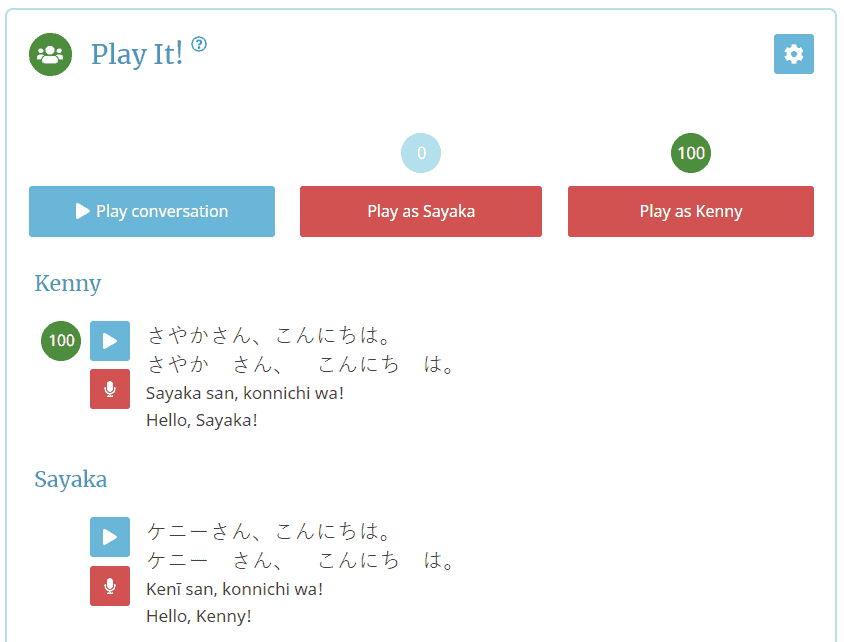
This is a pretty cool feature that lets you practice the dialogue as either one of the hosts. You’re essentially speaking the lines the host would have said, while the computer automatically plays the lines of the other host.
You’ll also record yourself speaking the sentences and receive grades on how accurate your pronunciation is. This feature is found throughout the course and there are three settings – Easy, Medium, or Hard, depending on how strictly you want to be graded.
This is awesome in theory, but the speech recognition software isn’t good enough yet to be something you can truly rely on. Sometimes, no matter how often I would say something, it’d be marked wrong, and other times, even if I intentionally made a mistake, it’d be marked correct.
That’s not a problem unique to Rocket Languages. Every single language learning product I’ve tried that uses voice recognition has the same issues.
I’d strongly recommend students to take some occasional classes on italki to get real feedback from a real person to make sure your pronunciation is alright. It’s actually a lot cheaper than most people would expect.
After the Play It! section, you’ll find Extra Vocabulary.
This part is pretty useful too since throughout the lessons, there will be some Japanese spoken that wasn’t a part of the main dialogue. You’ll find those words and phrases here.
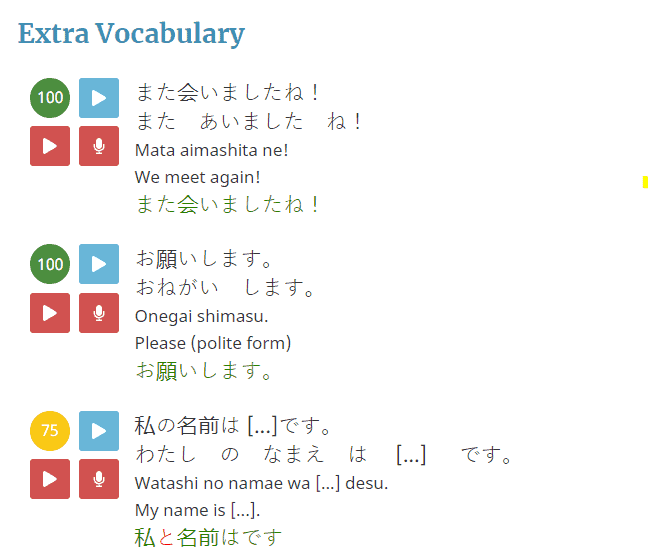
Just like before, you’re able to listen to the audio, record yourself, and receive a score on how accurate your pronunciation was.
The next part of the audio lessons is called Rocket Reinforcement! It includes several exercises and is also a part of both the Language & Culture and the Survival Kit Lessons.
Rocket Reinforcement!
The Rocket Reinforcement activities are the main way that you’ll practice Japanese throughout this course. Unfortunately, I’m not a huge fan.
The exercises are super repetitive and basically amount to using brute-force to memorize everything.
To say that they’re boring would probably be an understatement. The fact that this is the main way you’ll practice what you’ve learned makes me worried that students may become demotivated, lose interest, and give up studying.
Without a doubt, if you were to stick with the course and complete these exercises for each lesson, you’d learn a ton.
There are five different but somewhat similar exercises included in the Rocket Reinforcement. These are…
- Flashcards
- Hear it! Say it!
- Know it!
- Quiz
- Play it!
Let’s take a closer look at what each of these exercises entails.
Flashcards
The flashcards are probably my least favorite of all of the Rocket Reinforcement exercises.
They’re super straightforward: basically, you’re given a word and need to recall what the translation is. They’re big and ugly.
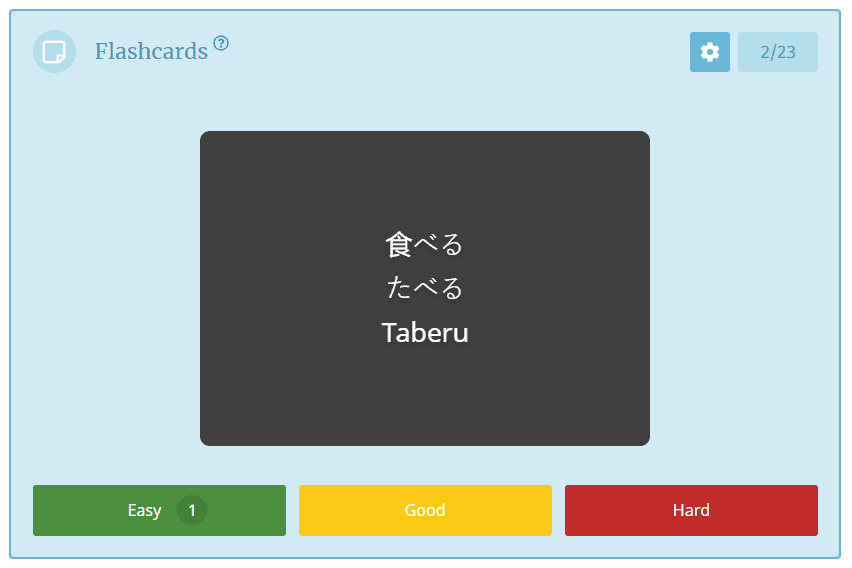
I think flashcards can be an extremely useful tool for language learning, but as included in Rocket Japanese, they’re pretty pointless.
I hate how only words from the current lesson are included.
You’ll get plenty of practice with the words in the current lesson, but it may have been quite some time since you’ve practiced what you learned in earlier units. Those are the words that you’d most benefit from reviewing with flashcards, otherwise, you’ll almost certainly forget them.
Memrise and Anki are two good platforms that do flashcards quite well.
Hear it! Say it!
In this part, you’ll hear a word or phrase in Japanese and then say it yourself. The voice recognition software will give you a grade. After recording yourself, you’ll be given the written form and you can mark whether it was easy, good, or hard.
Although the voice recognition software isn’t the most dependable thing, it does get you to practice speaking aloud, so for that alone, it’s useful.
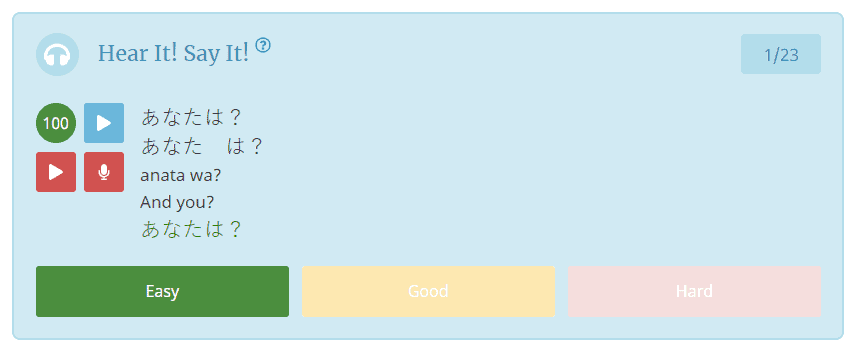
Know it!
In this section, you’ll test how well you know the words and phrases you’ve been studying. You’ll be given the word in English and need to recall and say it in Japanese.
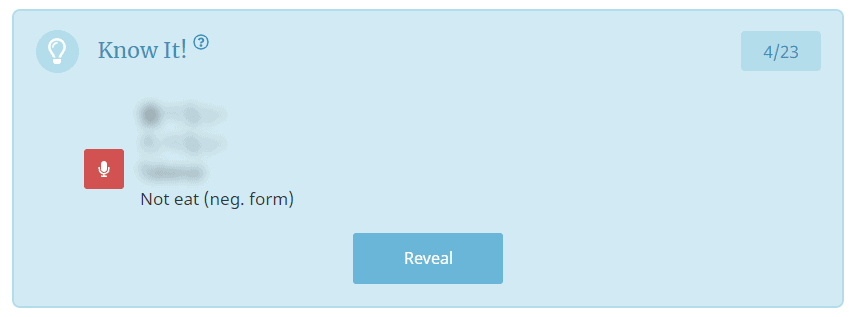
Quiz
The quiz has five to ten multiple-choice questions. These aren’t much different than any of the other exercises, as the majority of them seem to be translation based.
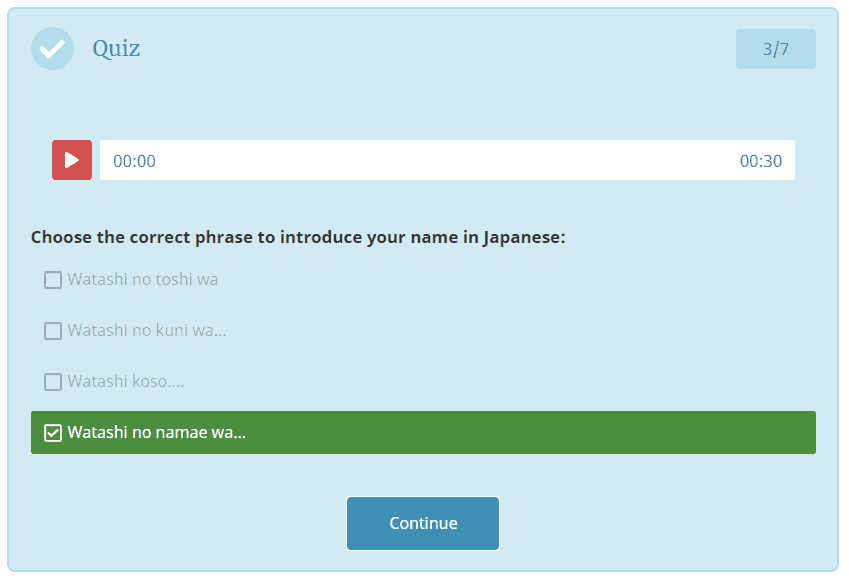
Extra Testing
Below the Rocket Reinforcement activities, some lessons also include an Extra Testing section. There are two activities here: Sort it! Kana and Sort it! Kanji.
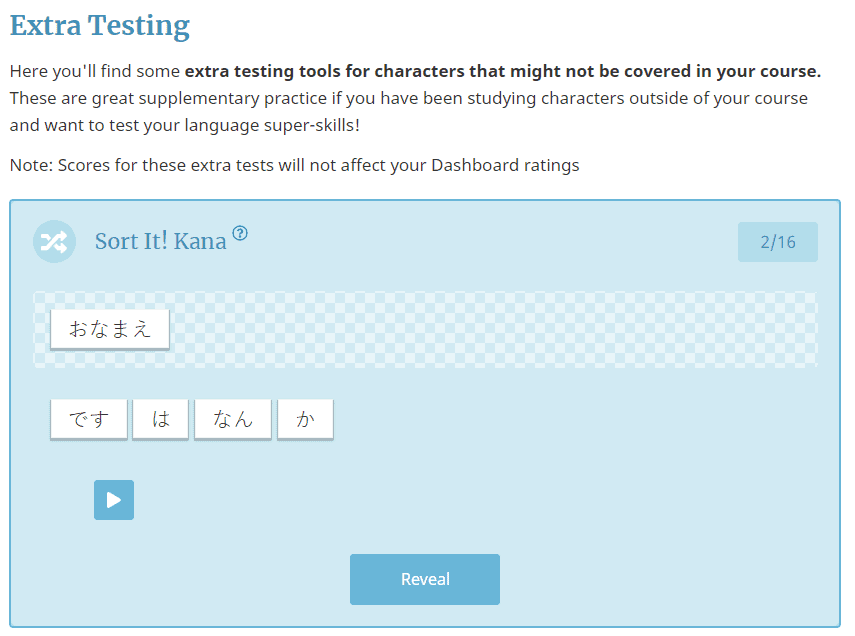
It’s a pretty straightforward matching activity. You’ll hear the audio of the target phrase and then need to put the words in the correct order. It’s nice that there’s this kind of practice, but you’ll need to supplement with other resources to really get your reading and writing skills up to snuff.
Language & Culture Lessons
Following the audio lessons in each module are the language and culture lessons. These can sometimes be super quick and other times very in-depth. They’re split into two parts, the first explaining things like grammar and the second talking about some part of Japanese culture.
After the lesson, you’ll find the same Rocket Reinforcement exercises.
The language part of these lessons is somewhat similar to what you might find in a textbook, but with the benefit of audio and exercises.
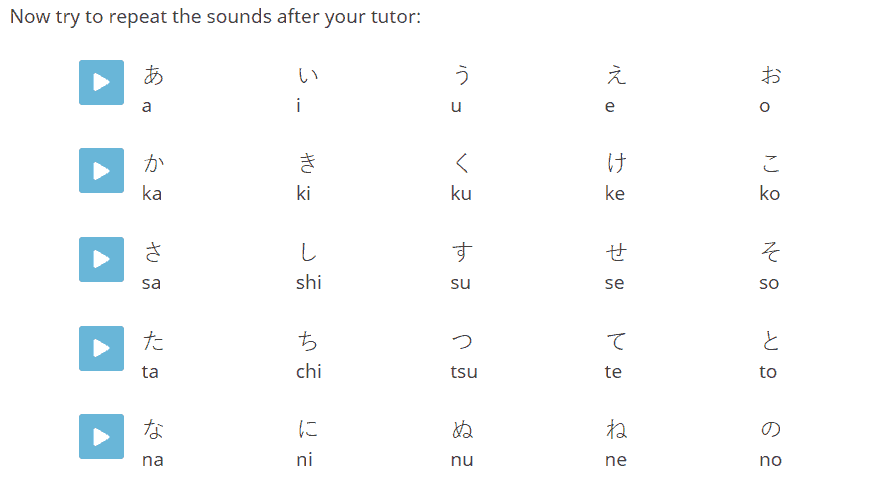
The way they’ve chosen to do some things doesn’t make much sense to me.
For example, learning the sounds and how they’re written is going to be very important for a beginner. This is one of those instances where the Rocket Reinforcement activities could actually be really useful. After all, drilling the sounds and how they’re written will make both reading and writing much easier.
But, instead, all of the Rocket Reinforcement exercises in this lesson included things that aren’t nearly as important for a beginner, such as learning the word ‘skillful’.
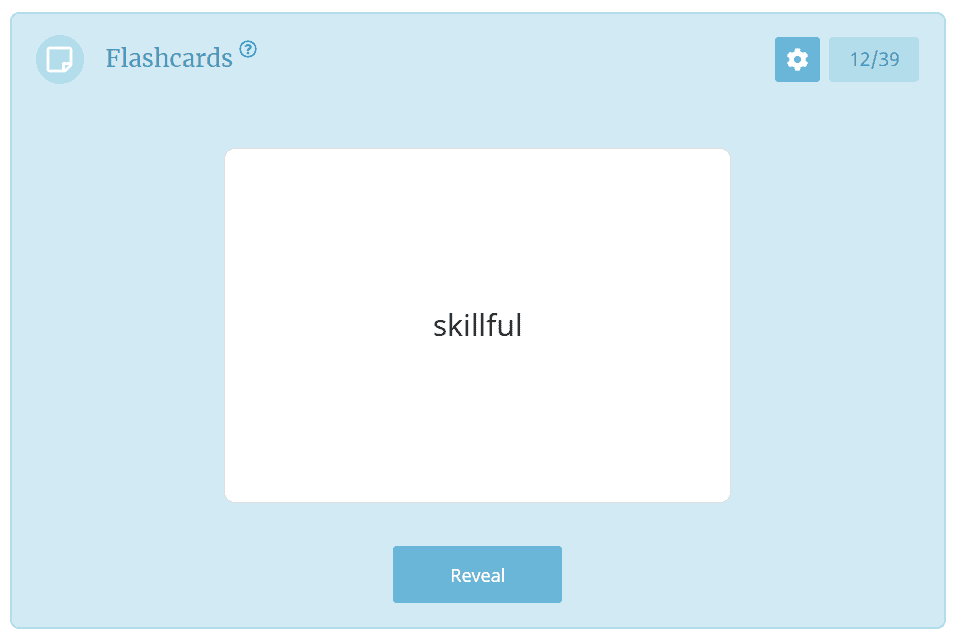
All that said, the explanations are generally pretty solid and contain lots of useful information.
The culture section is a written text about an aspect of Japanese culture. These can be fairly interesting, or rather boring, depending on the lesson.
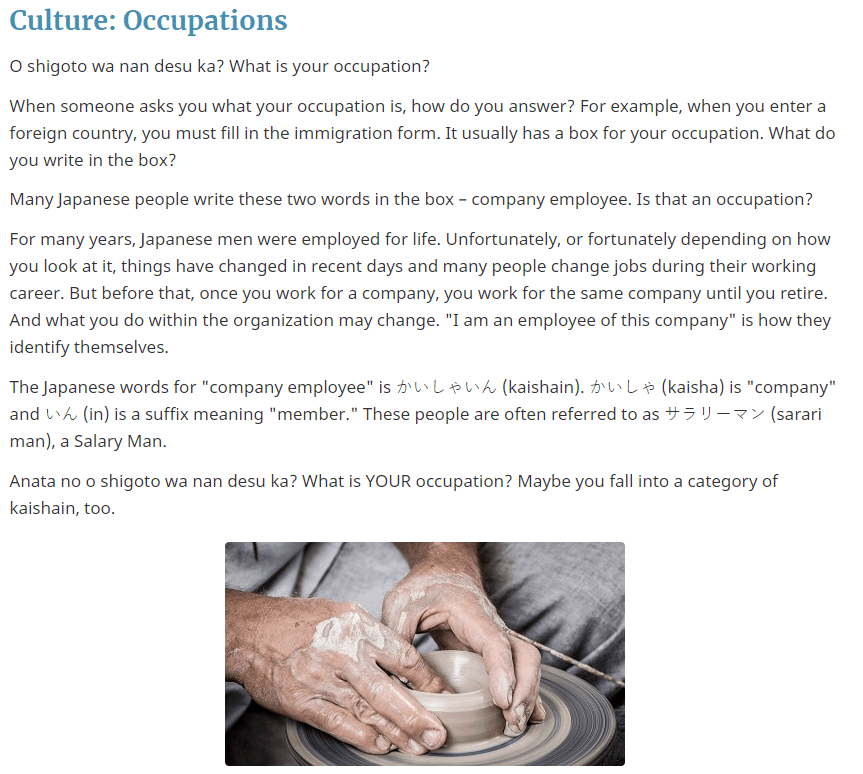
Just like the audio lessons, the same Rocket Reinforcement activities are found at the end of these lessons.
Writing Lessons
I found the first writing lesson that I tried to be quite useful, explaining the differences between Kanji, Hiragana, and Katakana.
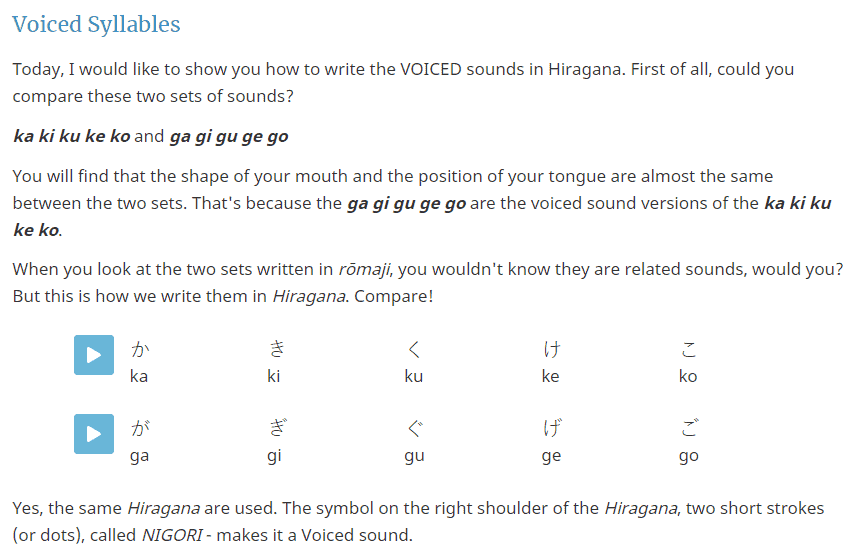
Similar to the Language & Culture Lesson that covered this topic, I liked that they took the time to explain the different sounds and how to read Hiragana. But, I found it odd and frustrating that there were no exercises to help you memorize these.
To me, it’s super strange. Rocket Japanese has such a strong emphasis on memorization exercises, yet there are none to help you memorize how to read Hiragana other than the Sort it! exercises, which just aren’t enough.
There are also lots of short videos ‘teaching’ you how to write Hiragana, Katakana, and Kanji. These videos are just short clips of somebody writing that character. If you’re serious about learning to write Japanese, I’d recommend using Skritter.
One thing I really liked is that there were some example words written with only the sounds you’ve learned up to this point.
However, for the most part, reading is neglected in Rocket Japanese. If you’re looking for more reading practice, it’d be worth checking out Satori Reader.
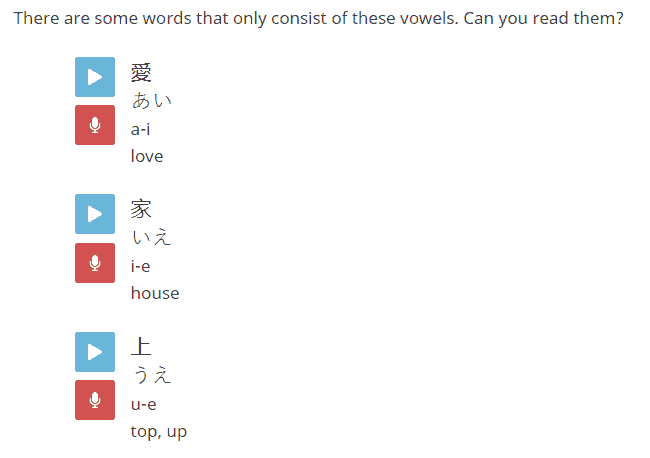
Survival Kit Lessons
There weren’t any survival kit lessons included in the free trial, so I didn’t get to test them for this review. But, I had tried some of these lessons for other languages taught by Rocket Japanese, and I’d expect these to be similar to those other languages.
They were very disappointing.
These lessons basically consisted of word lists related to some topic, such as parts of the body, clothing, colors, and so on. You could then practice these words with the Rocket Reinforcement exercises.
Not exactly very exciting stuff.
Price
There are three purchase options to choose from.
- Level 1 costs $99.95
- Levels 1 & 2 cost $249.90
- Levels 1, 2 & 3 cost $259.90

Is Rocket Japanese worth paying for?
I’m not sure.
I was definitely impressed with their course, but that’s largely because I had very low expectations going into it.
It seems to be a fairly thorough and well-structured course. I like their detailed explanations and all the speaking exercises available, even if their speech recognition software isn’t perfect. I think the written language is explained pretty clearly even if the exercises could be improved.
Although the audio lessons aren’t terribly exciting, they’re pretty good and balance grammar, speaking, and culture very well. I personally prefer the audio lessons of JapanesePod101, but that’s better as a supplemental tool to a more structured plan.
There’s a fair amount lacking with Rocket Japanese; for example, some reading exercises would fit in very well with the writing lessons. Instead, users would probably want to use an app like Satori Reader to get more reading practice or Skritter for extra writing practice.
I dislike their focus on memorization exercises and the fact that reviewing previously learned vocabulary isn’t incorporated into the lessons more naturally.
Although Rocket Japanese is very far from being perfect, it’s more balanced than other Japanese courses I’ve come across.
For example, Lingualift does very well with explaining grammar but lacks in exercises that will improve your spoken Japanese.
Rocket Japanese isn’t as good with the grammar and written language as those courses, but it’s far better for developing oral communication skills.
On the opposite side of the spectrum, Pimsleur is great for improving your speaking skills, but mostly ignores grammar and the written language.
Again, Rocket Japanese won’t get you speaking as well as Pimsleur, but it does far better with the non-speaking parts of the language.
From my perspective, Rocket Japanese doesn’t excel in any one area but is fairly good in a lot of different areas. This makes it a solid option worth considering, though there are other Japanese courses that I like more.

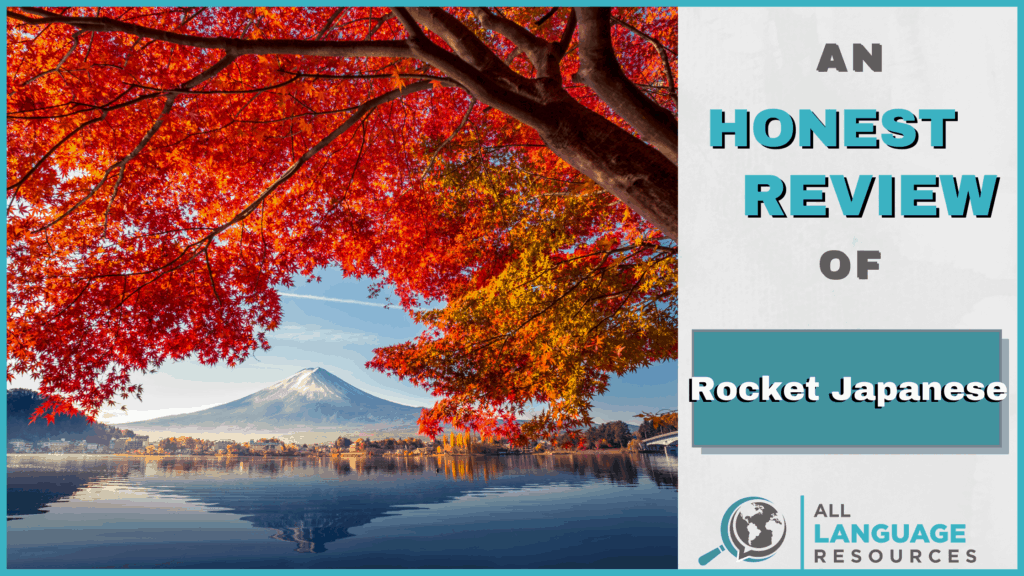
Really well balanced, useful and interesting article. Thank you for taking the time.